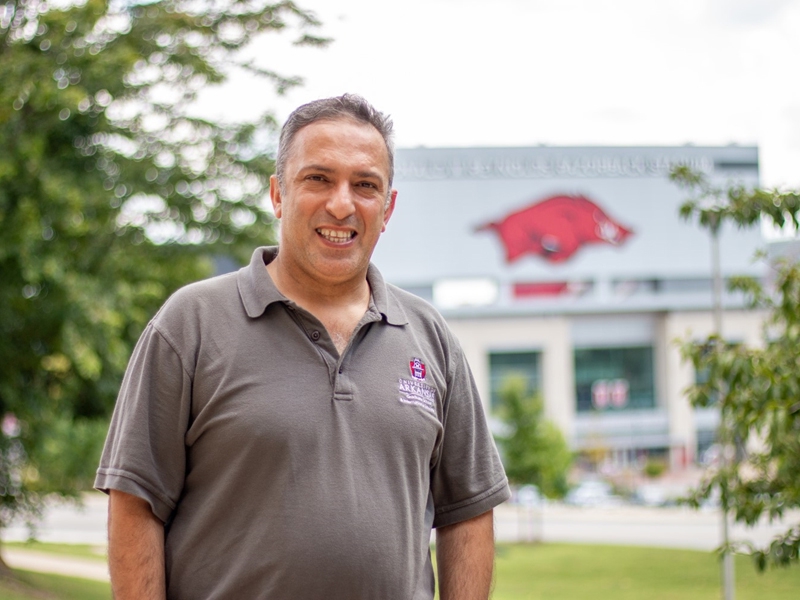Alrubaye Builds International Enrollment in Cell and Molecular Biology Program


Graduate and International Education at the University of Arkansas
Feb. 21, 2024
Introduction
Graduate and international education is all about discoveries — the discovery of knowledge, the discovery of research and creative scholarship that improves lives, and the discovery of new countries, cultures and people. The Graduate School and International Education is celebrating our students, faculty and staff that make discoveries happen at the University of Arkansas.
Adnan Alrubaye’s Passion for Poultry Research
Adnan Alrubaye’s passion for chickens began when he was a child growing up in southern Iraq, where he raised chickens to help provide eggs and meat for his family. Recognizing the importance of poultry as a food source, Alrubaye pursued his education at the University of Arkansas (U of A). As a student, alumnus, faculty member, and associate director of the Cell and Molecular Biology Program, Alrubaye has not only conducted research but also advocated for a more inclusive campus community for international students.
Early Influence and Educational Journey
Alrubaye’s parents instilled in him the belief in the power of education for personal growth and societal betterment. Encouraged by his parents, he pursued veterinary school and later completed his master’s degree in medical microbiology at the University of Baghdad. Wanting to pursue his Ph.D. in the United States, Alrubaye chose the U of A due to its reputation for academic excellence, research opportunities, cultural diversity, and lifelong learning.
Contributions to Poultry Science
As a graduate student in the Poultry Science Program, Alrubaye focused his research on mitigating diseases in chickens, specifically chicken lameness and pulmonary hypertension syndrome. His research has identified feed additives to improve gut health, immune function, and reduce lameness. Currently, he is working on developing a vaccine against lameness, which could save the poultry industry millions of dollars annually. Alrubaye’s goal is not only to increase chicken production but also to produce healthier birds.
Career at the University of Arkansas
After completing his doctorate, Alrubaye remained at the U of A as an assistant professor of poultry microbiology in the Bumpers College. He also teaches general microbiology in the Fulbright College of Arts and Sciences and serves as the associate director in the Cell and Molecular Biology Program. Additionally, he conducts research with the U of A System Division of Agriculture.
Advocacy for International Students
Alrubaye was hired to help recruit more international students from Arabic-speaking countries and has played a significant role in increasing enrollment in the Cell and Molecular Biology Program. He co-chairs the Scholars at Risk Committee, which brings international faculty members to campus to discuss their research. Alrubaye has also established an International Employee Impact Group and worked with Chartwell’s to diversify dining options for students, including Halal food. His aim is to make the transition easier for international students and faculty and create a welcoming environment on campus.
Reflection and Future Initiatives
Alrubaye reflects on the impact he and others in the international community have made to improve the campus. He believes in the power of education to shape the future and is committed to developing more initiatives to support international faculty, staff, and students. Having experienced the challenges of being an international student himself, Alrubaye considers the University of Arkansas his home and strives to make it a better home for everyone on campus.
SDGs, Targets, and Indicators
1. Which SDGs are addressed or connected to the issues highlighted in the article?
- SDG 4: Quality Education
- SDG 8: Decent Work and Economic Growth
- SDG 10: Reduced Inequalities
- SDG 17: Partnerships for the Goals
2. What specific targets under those SDGs can be identified based on the article’s content?
- SDG 4.3: By 2030, ensure equal access for all women and men to affordable and quality technical, vocational, and tertiary education, including university.
- SDG 8.5: By 2030, achieve full and productive employment and decent work for all women and men, including for young people and persons with disabilities, and equal pay for work of equal value.
- SDG 10.2: By 2030, empower and promote the social, economic, and political inclusion of all, irrespective of age, sex, disability, race, ethnicity, origin, religion, or economic or other status.
- SDG 17.16: Enhance the global partnership for sustainable development, complemented by multi-stakeholder partnerships that mobilize and share knowledge, expertise, technology, and financial resources.
3. Are there any indicators mentioned or implied in the article that can be used to measure progress towards the identified targets?
- Indicator for SDG 4.3: Percentage of students enrolled in higher education institutions who are international students.
- Indicator for SDG 8.5: Percentage of international faculty members employed in educational institutions.
- Indicator for SDG 10.2: Number of initiatives and programs implemented to support the social and economic inclusion of international students and faculty.
- Indicator for SDG 17.16: Number of partnerships and initiatives established to promote diversity and inclusivity in educational institutions.
SDGs, Targets, and Indicators
| SDGs | Targets | Indicators |
|---|---|---|
| SDG 4: Quality Education | 4.3: By 2030, ensure equal access for all women and men to affordable and quality technical, vocational, and tertiary education, including university. | Percentage of students enrolled in higher education institutions who are international students. |
| SDG 8: Decent Work and Economic Growth | 8.5: By 2030, achieve full and productive employment and decent work for all women and men, including for young people and persons with disabilities, and equal pay for work of equal value. | Percentage of international faculty members employed in educational institutions. |
| SDG 10: Reduced Inequalities | 10.2: By 2030, empower and promote the social, economic, and political inclusion of all, irrespective of age, sex, disability, race, ethnicity, origin, religion, or economic or other status. | Number of initiatives and programs implemented to support the social and economic inclusion of international students and faculty. |
| SDG 17: Partnerships for the Goals | 17.16: Enhance the global partnership for sustainable development, complemented by multi-stakeholder partnerships that mobilize and share knowledge, expertise, technology, and financial resources. | Number of partnerships and initiatives established to promote diversity and inclusivity in educational institutions. |
Source: news.uark.edu









